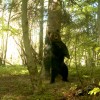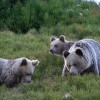Climate change is affecting our environment, and thus our societies and economy. Actions to reduce our greenhouse gas emissions and minimize the impacts of climate change have been taken at national and international level. Climate change is one of the main global threats to biodiversity of our times. In interaction with non-climate factors, particularly human-driven habitat changes, it represents the main force driving species decline and extinctions nowadays. Understanding how species respond to climate change is pivotal for the conservation of biodiversity and ecosystem management.
There is considerable variation in species responses and in the way different regions in the globe are affected by climate change. New species have colonized previously “cool” regions, whereas some Arctic species have contracted their range and other species have moved to higher latitudes and elevations. Phenological shifts suggest a trend towards spring advancement, like earlier frog breeding, bird nesting, first flowering, tree budburst and arrival of migrant birds and butterflies. Shifts in the seasonal timing can differ across trophic levels and result in a mismatch between resources and consumers, such as life cycles of predators and their prey, herbivorous insects and their host plants, parasitoids and their host insects, and insect pollinators and flowering plants, which may finally lead to population declines. Apart of these two climate-induced shifts (range and phenology), evolutionary adaptation to climate change at the local scale, including greater dispersal rates or broader diet at the range limits, has also been documented.
The impact of climatic changes in boreal and mountain ecosystems in Europe has started to be evident. In Sweden, treelines have shifted towards north. Vascular plant species in boreal-temperate mountain regions in Europe have moved upslope. Whereas the boreal region is projected to lose few plant species and gain many others from immigration, an excess of vegetal species loss is predicted for the mountains regions of Europe, including the Carpathians. The recent trend of increasingly warm winters in northern Europe and Scandinavia cause female red deer Cervus elaphus to become smaller, which may lead to reduced fecundity. The range of Fennoscandia birds is expected to suffer large reductions in the next decades due to climate changes, enhaced by the Arctic Ocean representing a barrier to northwards movements. Due to climate change, in synergy with fragmentation levels and barriers to migration in Europe, an important portion of European mammal species are expected to lose more than 30% of their current distribution.
Large carnivores inhabiting northern latitudes may be good indicators of ongoing climate and environmental changes. The best example is the polar bear, which has been object of much research on climate change impacts and become the iconic symbol of a melting Arctic. Its sister species, the brown bears, may also be a model species in climate change research, particularly in the boreal and alpine ecosystems; however, it has received little attention in this respect. The brown bear is an omnivorous species which shows low reproduction rates and goes into hibernation. Their ecology and physiology are largely influenced by climatic conditions. Recent observations from the brown bear Carpathian population suggest modification in their typical behaviors, probably linked to changes in the winter conditions. For example, non-hibernating bears are being increasingly observed during winter in many areas in Europe. Winter is a period of low food availability, and hibernation an adaptation to those conditions. Shortening of the bear denning period or increased bear activity during winter may, therefore, produce a trophic mismatch. Mistiming with crucial bear foods during hyperphagia, when bears have to gain weight for winter denning and successful reproduction, may also have important consequences. Climate-induced changes in bear denning, foraging patterns or potential range shifts into new areas may also affect the occurrence of human-bear conflicts and how bears are perceived and valued.





















